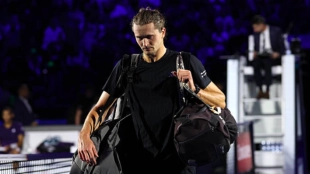
Interesting press conference offered this morning in Turin by Andrea Gaudenzi, president of the ATP, addressing significant topics regarding the Calendar, the two-week M1000, the Davis Cup, and what is to come in the upcoming years.
About the ATP Calendar and 250 tournaments
In recent years, we have reduced the number of ATP 250 tournaments. From 38, I believe it has decreased to 29. The goal for 2028 with the upcoming Arabian Masters 1000 is to reduce them even further. The 250 events are essential, as well as the 500s and Challengers. Each category is important, but we currently have too many.
The year consists of 52 weeks, and players need a preseason. Currently, the offseason is very short. They need rest, vacations, and time to work on their bodies and tennis. Within this, there are seven entities involved. Each of the four Grand Slams operates independently with its own dates. Then there's the ITF with the Davis Cup, followed by the ATP and WTA. It's challenging to have a unified approach in this scenario.
Our strategy has been clear: focus on our premium product, the Masters. We need to provide fans with the best possible experience. Fans love seeing the top players competing against each other, a spectacle evident in the Slams, M1000s, and Finals.
However, we face a dilemma with players being independent professionals. Each one chooses where they want to compete. Some may prioritize a 250 over a 500, or a 500 over a 1000. We offer incentives, trying to influence their decisions, but ultimately, they choose where to play. It's a complex issue because players are attracted to money and may participate in lower categories or exhibitions outside the system as well. I believe that if we all come together at one table—Slams, ITF, ATP, and WTA—under one regulation, we can do a better job with the calendar.
Two-week Masters 1000, criticisms, and advantages
I was a player ranked around 50-55 and could only enter one or two M1000 main draws. Yet, I played in all the Slams and wondered, how can I play the Slams but not the M1000s? Hence, I think it's crucial to have a 96-player draw for the M1000s, allowing the top 100 players to compete in these events, with the exceptions of Monte Carlo, Paris, and the Arabian Masters.
Indian Wells and Miami have operated in this manner for 35 years. I didn't invent this concept; I arrived, saw the numbers, and realized their success exceeded others. Why do the Slams enjoy such popularity? Infrastructure, history, the brand. A 15-day tournament can sell numerous tickets. Tennis heavily relies on ticket sales for revenue, constituting around 50-60% of a tournament's profits. In other sports, sponsorships hold more weight in profits.
By extending tournament lengths, as seen this year with Canada or Cincinnati, one can observe the positive impact through increased ticket sales. This extension also allowed us to offer over 20 million in bonuses to players, a substantial increase from the previous 6 million. This additional revenue benefits the entire ecosystem, also reaching players ranked 100 or 150.
There may be concerns about the players staying at a tournament for an extended period, but we need a couple more years to evaluate the plan and compensate players advancing further in tournaments since their success contributes to the overall value.
Players may believe they can generate more revenue in a single day at an exhibition than in a 12-day M1000 event. This is our current challenge. We need a couple of years to assess the system's effectiveness and make decisions. With everyone's commitment, we can benefit the entire ecosystem. I just ask everyone for some patience.
Future Calendar Changes
Our aim is to have around 10 250 tournaments, about 8 500s, the 10 Masters 1000, totaling 32 events with the four Grand Slams. If you are at the top, you will play all four Slams, the 10 Masters, and maybe a 500 event. Further down, you would participate in more 500s and 250s. Even lower, 250s and Challengers. In my opinion, for players like Sinner or Alcaraz, there's no need to compete in a 250 solely for financial gain; their level and ranking do not warrant it. They have the M1000 for that.

Finals on a Monday or Wednesday
Regarding Cincinnati, we have agreed that the final will be on a Sunday in 2026. Due to the limited time available after Wimbledon, with Canada, there was no alternative but to schedule it on a Wednesday. Other sports also have finals on Mondays or Wednesdays, like the Champions League. I believe in a new era of more flexibility. Let's evaluate next year the impact of a Sunday final versus a Monday in terms of TV viewership. We must remain adaptable to scheduling changes.
Ideal Preseason in Weeks and Davis Cup
Some may suggest six weeks, others seven or eight. It's clear that a tennis player needs one or two weeks off. Following this, another week or two for physical training. I believe preseasons should be longer than they currently are. Some players, like myself, finish their year in Paris in early to mid-November. Top players also have the Finals and the Davis Cup in their schedule.
Regarding the Davis Cup, I played my best matches in this competition. I think it should evolve into the tennis World Cup. The best format is the home and away matches. I recall playing the final in Milan, probably the finest memory of my career. Playing against Agassi and Sampras in Palermo or against Zimbabwe in Florence. Regardless of the venue, crowds fill arenas in locations where tennis isn't commonly seen to support their national team. This atmosphere is the essence of this event.
The challenge lies in the surface changes within the Davis Cup. Playing on clay in one tie and then transitioning to hardcourt in Dubai the next day is complex. I propose having the Davis Cup as a home and away event every two years. There isn't an annual World Cup in other sports from what I understand. This adjustment would add value to the event and significantly ease the scheduling burden.
This news is an automatic translation. You can read the original news, Se viene la REVOLUCIÓN: Así cambiará el Calendario ATP en los próximos años

















